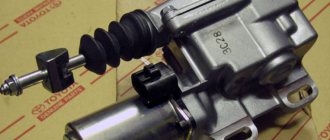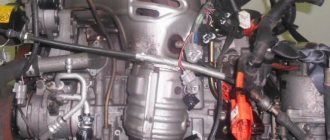05.11.2021 27 150 Transmission
Author: Victor
Due to the fact that CVTs have appeared recently and finding specialists to repair them is problematic, it is believed that such a unit is not very reliable. In this article we will tell you what the resource of the Toyota Rav 4 variator is and what needs to be taken into account when operating it in order to prevent premature failure.
[Hide]
Design and principle of operation
A CVT gearbox is the only type of unit that allows you to continuously change the gear ratio between the transmission and the power unit. The vehicle picks up speed without increasing engine speed.
The design of CVT cars of Toyota Rav 4 2010, 2011, 2013 and other years of production includes two sliding shafts. They interact with each other through a strap stretched between them. One of these pulleys is connected to the power unit and is considered the drive, and the second - the driven - is connected to the drive wheels. Both pulleys consist of two halves. When these elements move together, the strap is pushed out, and when they move apart, it falls in. As a result of a synchronous change in the radii of the parts along which the strap moves, the diameter of one shaft increases and the other decreases. This contributes to a smooth change in gear ratio. If the drive shaft is smaller than the driven shaft, the vehicle moves at a reduced speed. With equal pulley diameters, the car drives in direct gear. If the driven shaft size is smaller, the machine moves at higher speed.
Toyota CVT transmission
A torque converter device is used as a clutch in Toyota Rav 4 2014, 2015, 2016, 2021 gearboxes. This unit is large in size and weight. Its presence in the design allows for smooth starting of the car and eliminates jerking during acceleration. Thanks to the use of a torque converter device, the vehicle shifts faster from a low gear to a higher one if the driver presses the gas pedal hard. To allow the car to move backwards, the transmission uses a planetary gear.
The operation of the CVT transmission is controlled by a control system, which includes a central processor, a controller, and a shaft control unit. The control module receives information about the speed of the vehicle, the speed of the power unit, as well as the position of the gas pedal. In accordance with these data, the central processor selects the gear ratio for a specific driving mode. If the information about the rotation of the primary and secondary pulleys does not match, then the control module sends a command to the hydraulic system to change the size of the shafts. The operating pressure in the system is provided by a pumping device. The same unit lubricates the internal parts of the gearbox.
You can learn more about the operating principle of a CVT transmission from a video filmed by the Toyota Russia channel.
The pressure parameter in the system is usually not determined by the speed of the power unit, but is maintained proportional to the developing torque. As this indicator increases, the discs are compressed more strongly, which helps prevent the strap from slipping. The amount of pressure generated by the pumping device determines the speed of the CVT gearbox. The larger this parameter is, the faster the gear ratio will change. To lubricate internal parts and components, a special lubricant is used, intended for Toyota Rav 4 CVTs and produced by the car manufacturer.
Life time
Now let’s look at how long continuous variable transmissions last on average. According to reviews from owners, the unit is reliable and on average lasts about 100-150 thousand kilometers, without causing any inconvenience to the motorist. Only after this interval are the first malfunctions of the gearbox possible.
Similar, but not the same
The solution used by Toyota brings to mind the Jatco CVT7 (JF015E) variator, which has been in production for almost 10 years, since July 2009 - this is the world's first variator with a mechanical two-stage gearbox. However, JATCO has supplied the CVT and gearbox in series, and torque is always transmitted through one of the gear pairs and the CVT. And in Direct Shift-CVT, the gear pair and the variator are used, so to speak, alternately in parallel - the moment is transmitted either by the gear pair or by the belt on the pulleys.
Insert video:
How does the Jatco CVT7 variator work?
Basic faults
Transmission problems do not always appear gradually. Therefore, if the variator breaks down, it can quickly lead to the inability to control the car.
Damaged metal variator belt
Failed differential flange
Worn damaged support bearing
CVT repair
What problems are typical for CVT and how to repair the box in a car with a 2-liter engine or another volume:
- Failure of the planetary gear set. When the unit operates under high load conditions, this leads to the destruction of the gear axes, and as a result, their teeth break. In this case, the teeth must be replaced.
- Oil starvation. In the absence of lubrication and the engine operating at high speeds, when the car is used off-road, damage to the planetary gear occurs. You can see such a malfunction when replacing the filter device. The magnets installed in the tray collect wear products in the form of metal shavings; you need to inspect them. If the vehicle's mileage is more than 150 thousand km, and the size of the steel chips is more than 1 mm, this indicates that a chain reaction of gear destruction occurs during the operation of the unit. If you do not take any action, the gearbox planetary gear may damage the pumping device and other components of the gearbox. In this case, repairs will be expensive.
- Front gear failure. When operating a vehicle in aggressive conditions, damage to this part occurs. The wear products of the element ultimately damage the ring gear. If you do not solve the problem in time, the presence of metal shavings can damage the rear planetary gearbox. As a result, the clutches will fail.
- With intensive use, especially in off-road conditions, rapid wear of the support bearing devices occurs. We are talking about parts located on the primary and secondary shafts. Fixing this problem is quite difficult, since you will not find bearings for Toyota CVTs on sale. CVT parts are not available on the aftermarket. Therefore, to solve the problem, you will have to look for bearings at a car disassembly or buy similar ones in size and turn them on a lathe to fit the dimensions of the installed parts. This repair option is considered the cheapest.
- Sensor failures. CVT transmissions are equipped with a large number of different electronic controllers designed to read data and transmit it to the control unit. The failure of one sensor can affect the functionality of the CVT as a whole. If the diagnostics show a failure of the controller, it is necessary to carry out a detailed check of it. It is necessary to check the connectors and contacts. Often the cause of malfunction lies in damage to the plug.
- Malfunctions in the operation of the control system. If the central processor fails, the transmission will not work. If the control module is malfunctioning, but is still functioning, the gearbox will work, but intermittently. It is better to entrust the solution to problems in the operation of the control unit to professionals. Sometimes it is necessary to reflash the unit, but it is almost impossible to do it at home.
- Broken drive belt. Due to rapid wear and improper use, the drive belt may break. Its links can scatter throughout the gearbox and damage other components of the variator.
Damage to the differential flange is especially dangerous. The drive for the so-called transfer transmission passes through a flange on the differential housing. This element has thin walls and in practice problems often occurred when the part burst due to operation under constant high loads. This leads to lubricant leakage. If it is not detected and resolved in a timely manner, the transmission fluid may completely drain from the box. In addition, the flange will crumble in the system and its fragments will fall on the gears of the transmission, which will lead to damage to transmission parts. The difficulty of repair lies in the fact that differentials for CVT gearboxes cannot be found on sale.
The car owner has the option of purchasing a new complete unit, which will cost more than 15 thousand dollars. The problem can be solved by installing a contract variator, but finding such a unit on sale is problematic. Moreover, the cost of such a unit will be quite high. The best way to solve the problem is at the stage of oil leaks and cracks. In this case, any suitable tightening sleeve must be pressed over the damaged flange and traces of leakage must be removed. But keep in mind that it is impossible to give exact guarantees about the durability of such a solution. Usually, after such manipulations, car owners try to sell the vehicle as quickly as possible.
The Automatic Transmission Technology channel has published a video showing the process of repairing a Rav 4 transmission with a broken belt.
LEGENDS AND FACTS
It was not possible to identify a clear winner based on the sum of four tests. It seems that Nissan, which, we recall, has the latest version of the variator (this unit will soon be installed on other models of the Japanese brand), scored half a point more than Subaru. But after consulting, we decided to divide first and second places between these cars. After all, the fractions of a second lost by Nissan during intense acceleration are fully compensated by good results in the Curb test. Mitsubishi lagged behind its rivals just a little. In general, all the cars performed very well and helped dispel some myths about the unviability of CVTs. In normal, everyday use, continuously variable transmissions will not cause any trouble. Of course, if you remember simple truths: crossovers, especially those with a continuously variable transmission, are not SUVs at all! These are city and highway cars that allow you to overcome not very difficult obstacles from time to time. And it’s even more honest to call a single-wheel drive a station wagon with increased ground clearance.
Killing a continuously variable transmission is not easy. Wise electronics will protect the car from a driver who overestimates it and his abilities. Well, we made it! But with many of today's drivers, it probably wouldn't be any other way.
Nissan Qashqai - 1st-2nd places
"Subaru-Forester" - 1-2 places
Mitsubishi Outlander - 3rd place
Testing 4 crossovers with CVTs: chain reactions
Rules of operation and maintenance
What nuances should be taken into account in order not to reduce the resource of the Toyota Rav 4 variator:
- Do not start moving from a standstill by pressing the gas pedal all the way. The structural elements of the gearbox are subject to high loads, which will lead to damage to parts.
- Do not tow other vehicles. Towing trailers is also not recommended. CVT gearboxes are designed to work with a certain vehicle weight and cannot be increased.
- Reverse gear cannot be engaged or disengaged until the car has come to a complete stop.
- Try to drive less at top speed. This may cause the engine speed to fluctuate.
- Avoid wheel slip. Cars often slip when they get stuck in mud or snowdrifts. You should not try to drive out of an obstacle while rocking, alternately turning on modes R and D. This will lead to a decrease in the service life of the CVT transmission. It is better to put the car in neutral and ask someone to pull the car out of the obstacle.
- When the emergency mode is turned on, the car owner needs to turn off the power unit of the car and try to start it again. If the box works normally after restarting the engine, you can continue to use it. If the emergency mode remains, then diagnostics of the unit is required, and it is advisable to perform it as quickly as possible.
- During the cold season, always warm up the transmission. The car engine heats up faster than the transmission, so when the engine warms up, you cannot assume that the transmission has also warmed up. At low negative temperatures, it will take at least 10 minutes to fully warm up the unit. Only after this is it possible to drive at normal speed. To warm up the transmission faster, you can turn on all modes on the gearbox selector one by one, staying in each of them for a few seconds. This will allow the oil to circulate faster through the channels of the transmission system.
- During the operation of the vehicle, we must not forget about the need to regularly check the oil level. If diagnostics show that the lubricant in the system is less than normal, you need to check the condition of the gearbox. The cause may be a fluid leak. If wear debris is visible in the oil, and there is also a burning smell coming from it, the lubricant must be replaced. Please review the service book before performing this task. According to the regulations, the manufacturer prohibits the use of any oil other than Toyota Genuine CVT Fluid TC or Toyota Genuine CVT Fluid FE in transmissions. The use of consumables from other manufacturers may cause problems with the transmission. You may feel vibrations in the area of the gear selector, and the lever itself may jam. In some cases, complete failure of the unit is possible if the quality of the lubricant does not meet the standard.
- You cannot turn on the neutral gear mode at every short stop, in a traffic jam, at traffic lights, etc. If you know that you will be standing for a long time, turn on the parking sensors mode. Neutral speed is considered an emergency speed. It can be turned on if the car needs to be pulled out of a snowdrift.
- Avoid off-road driving. Toyota RAV4 belongs to the class of crossovers, but the CVT transmission installed on these cars is not intended for regular operation on bad roads or rural areas.
The Automatic Transmission Technology channel provided a video, the author of which talked about what nuances to take into account during operation in order to increase the service life of the CVT gearbox.
Advantages and disadvantages
To understand which is better - a CVT or an automatic, you need to understand the pros and cons of CVT transmissions.
Advantages:
- Lower fuel consumption compared to automatic transmissions. Due to the absence of actual gear shifting and constant operation at the optimal speed, engines with CVT gearboxes operate more economically. The volume of harmful substances released into the atmosphere with exhaust gases is also reduced.
- Smooth gear changes while driving. Thanks to this, when the vehicle speed increases, there are no jerks or shocks. Because of this, the service life of individual gearbox components also increases.
- Reliability of the unit.
- Good car dynamics.
- Light weight gearbox.
Flaws:
- Noisy. The effect of a CVT transmission can be compared to the noise a trolleybus makes while driving.
- Transmission sensitivity. When using cars with CVT gearboxes, you must strictly adhere to the operating and maintenance rules. Otherwise, it may damage the structural elements of the gearbox and affect the service life.
- Expensive and difficult to repair. If the structural components of the gearbox break down, it is problematic to find new parts. They are not always on sale.
variators
Rivals: Mitsubishi Outlander (2.4 l, 167 hp, all-wheel drive, CVT with six virtual gears), Subaru Forester (2.0 l, 241 hp, all-wheel drive, CVT with eight virtual gears), Nissan Qashqai (2 liters, 144 hp, all-wheel drive, CVT with seven virtual gears), Toyota RAV4 (2 liters, 146 hp, front-wheel drive, CVT with seven virtual gears)
Rivals: Mitsubishi Outlander (2, 4 l, 167 hp, all-wheel drive, CVT with six virtual gears), Subaru Forester (2.0 l, 241 hp, all-wheel drive, CVT with eight virtual gears), Nissan Qashqai (2 l, 144 hp, all-wheel drive, CVT with seven virtual gears), Toyota RAV4 (2 l, 146 hp, front-wheel drive, CVT with seven virtual gears)
They overheat at high speed and are not viable outside of smooth asphalt! They fail even under non-critical loads!
Rumors about the dubious reliability of continuously variable transmissions (CVT) appear almost faster than the release of the next new model with a CVT. Moreover, they are born more often around all-wheel drive crossovers, the transmissions of which are the most loaded and often work to the limit - especially on rough terrain. And these rumors are not without foundation: there are problems! As practice shows, they also happen in less offensive situations - even on city asphalt.
That’s why we tested three all-wheel drive crossovers in diverse tests - the new Nissan Qashqai with an upgraded transmission of the latest generation, the Subaru Forester and the updated Mitsubishi Outlander. And outside the competition, a single-wheel drive Toyota RAV4 took part in our tests. Now you can buy one, and with a CVT.
Video “How to change the oil in a Rav 4 CVT transmission?”
User Andrey Florida in his video explained in detail and showed how to change the lubricant in the CVT gearbox of a Toyota Rav 4.
Do you have any questions? Specialists and readers of the AUTODVIG website will help you ask a question
Was this article helpful?
Thank you for your opinion!
The article was useful. Please share the information with your friends.
Yes (95.45%)
No (4.55%)
X
Please write what is wrong and leave recommendations on the article
Cancel reply
Rate this article: ( 91 votes, average: 4.87 out of 5)
Discuss the article:










